What is Erif file extension
.Erif file extension is a filename extension that is used by the 242th version of the STOP ransomware to mark files that have been encrypted. This means that all files with this filename extension are encrypted by ransomware, which received the name ‘Erif ransomware’. Like other ransomware, it is created to encrypt the victim’s files, and then demand a ransom for decrypting them. Fortunately, a group of security researchers created a free Erif File Decrypt Tool. Erif File Decrypt Tool is a free decryptor that can help the ransomware victims decrypt .erif files. In addition to the decryptor, there are several more methods, each of which can help restore the contents of encrypted files. Read more about this, as well as how to remove Erif ransomware virus and protect your computer from such ransomware below.
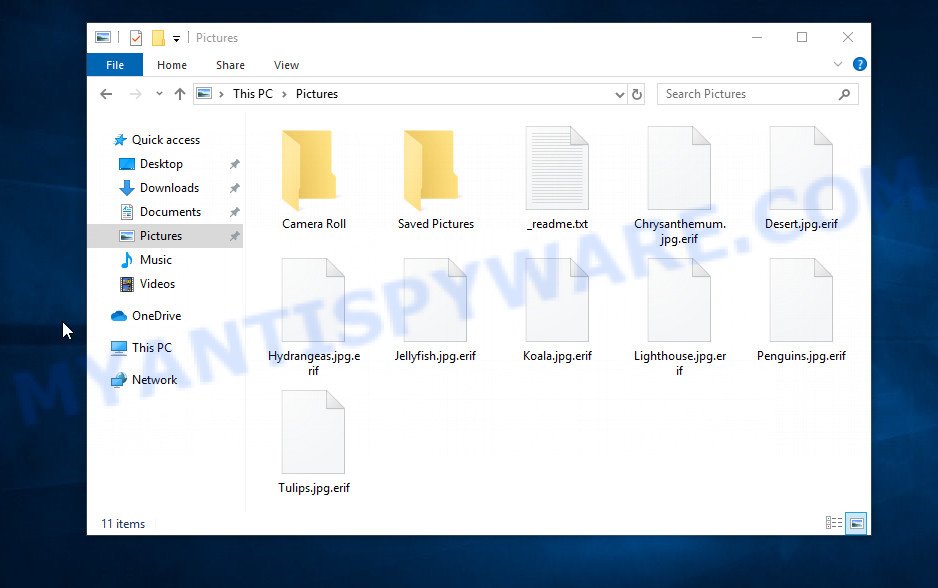
Screenshot of files encrypted by Erif virus (‘.erif’ file extension)
What is Erif ransomware
Erif ransomware is a new malware that belongs to the STOP (Djvu) ransomware family. According to security researchers, this malware is not much different from previous variants of STOP ransomware, such as Kuus and Repl that were discovered earlier. Like other variants of STOP ransomware, the Erif virus is distributed by websites offering to download torrents, cracked games, freeware, key generators, activators and so on.
Upon execution, the Erif ransomware creates a folder in the Windows system directory where it places a copy of itself and changes some Windows settings so that it starts up every time the computer is restarted or turned on. The virus collects information about the victim’s computer and then tries to establish a connection with its command server (C&C). If the connection has been established, then it sends information about the infected computer to the server, and in response receives the encryption key (the so-called ‘online key’) and additional commands and malware that must be executed on the victim’s computer. If the Erif ransomware could not establish a connection with its command server, then it uses a fixed key (the so-called ‘offline key’).

The Erif ransomware encrypts files using a strong encryption algorithm and a long key (‘offline key’ or ‘online key’, as described above). The virus tries to encrypt as many files as possible, for this it only encrypts the first 154kb of the contents of each file and thus significantly speeds up the encryption process. The Erif ransomware has the ability to encrypt files on all drives connected to the computer: internal hard drives, flash USB disks, network storage, and so on. It skips without encryption: files located in the Windows system directories, files with the extension .dll, .lnk, .ini, .bat, .sys and files with the name ‘_readme.txt’. The remaining files located on the victim’s computer can be encrypted. For example, the following file types may be the target of ransomware attack:
.fpk, .qic, .wma, .orf, .1, .xmmap, .cer, .pdd, .wsh, .rim, .esm, .docm, .x3f, .forge, .bsa, .doc, .odm, .ws, .cdr, .raw, .kdb, .dxg, .xld, .ltx, .wotreplay, .pptm, .d3dbsp, .xf, .rar, .upk, .wri, .odp, .wp5, .wbd, .y, .iwi, .nrw, .sav, .zip, .sql, .dbf, .bik, .7z, .mrwref, .ods, .layout, .sidn, .mddata, .wmd, .x3d, .jpeg, .slm, .xx, .wbk, .lrf, .icxs, .tor, .wps, .hvpl, .wp6, .sie, .mdf, .vfs0, .kf, .dng, .dwg, .ff, .pst, .ptx, .docx, .xar, .dba, .cr2, .wmv, .mcmeta, .das, .odt, .avi, .png, .csv, .rtf, .ysp, .gdb, .lvl, .wpd, .xlsx, .w3x, .xll, .wcf, .mdbackup, .kdc, .zip, .flv, .ybk, .lbf, .pfx, .p7b, .sr2, .xmind, wallet, .epk, .sum, .itl, .crw, .bkp, .wps, .litemod, .webdoc, .m4a, .rwl, .ai, .accdb, .mpqge, .vdf, .xpm, .mef, .svg, .wbmp, .3fr, .ntl, .xbdoc, .wpl, .t12, .pem, .fos, .desc, .gho, .map, .re4, .fsh, .odc, .pak, .wbc, .p12, .ncf, .ibank, .indd, .yal, .xml, .xlsm, .wbm, .wmv, .raf, .webp, .wpt, .srw, .mp4, .wp7, .hkx, .xyw, .odb, .xlsb, .rb, .zif, .wire, .txt, .mov, .p7c, .m2, .erf, .db0, .js, .zdc, .z, .dcr, .r3d, .big, .ztmp, .arch00, .yml, .blob, .wma, .sidd, .xlsm, .wpa, .cas, .jpg, .syncdb, .sid, .wsd, .xlk, .cfr, .wp4, .vpk, .wgz, .wdb, .zabw, .snx, .t13, .py, .wp, .0, .vcf, .xxx, .der, .asset, .rgss3a, .zi, .3dm, .dmp, .jpe, .bc7, .bc6, .z3d, .crt, .wpe, .m3u, .zw, .bkf, .srf, .wmo, .mdb, .wpd, .zdb, .wav, .wpb, .mlx, .1st, .itm, .xls, .x3f, .bar, .xyp, .xbplate, .wdp, .menu, .xwp, .apk, .vtf, .xlgc, .psk, .xdl, .hkdb, .pptx, .ppt, .xy3, .pkpass, .wn, .wsc, .wpw, .bay, .arw, .rw2, .wpg, .wbz, .x, .rofl, .eps, .sb, .pdf, .wb2, .tax, .xlsx, .qdf, .iwd, .xls, .itdb, .psd, .3ds, .xdb, .hplg, .2bp
The Erif ransomware encrypts file-by-file. Each file that has been encrypted will be renamed, the .erif extension will be added at the end of its name. This means the following. If the file had the name ‘mydocument.docx’, then after the virus encrypts it, this file will have the name ‘mydocument.docx.erif’. In every directory where there is at least one encrypted file, the virus places a file named ‘_readme.txt’. The file contains a message from Erif authors. An example of the contents of this file is given below.
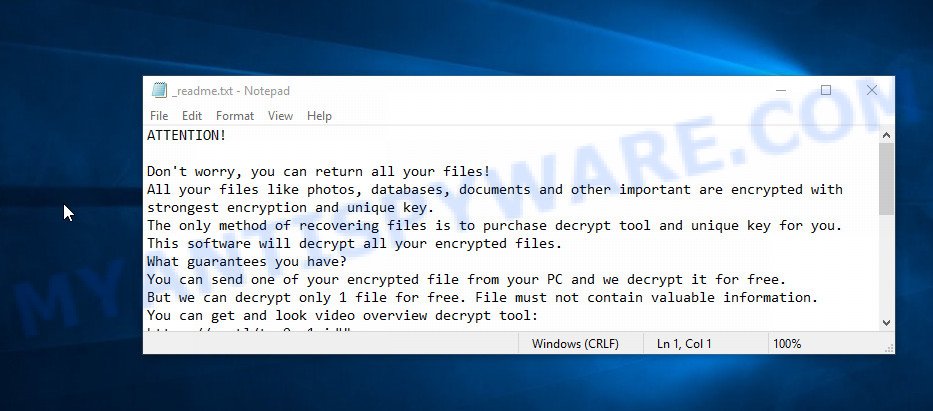
Screenshot of the contents of ‘_readme.txt’ file (Erif ransom note)
This message says that all files on the computer are encrypted and the only way to decrypt them is to buy a key and a decryptor from the Erif ransomware authors. That is, criminals demand a ransom for unlocking the victim’s files. The size of the ransom is $980, but if the victim is ready to pay the ransom within 72 hours, then its size is halved to $490. Attackers offer victims to verify that encrypted files can be decrypted. To do this, the victim must send them a small file to one of the email addresses specified in the ‘_readme.txt’ file. Of course, it is obvious that a single decrypted file cannot guarantee that after paying the ransom, the criminals will provide the victim with a working key and decryptor.
Threat Summary
| Name | Erif ransomware, Erif File Virus |
| Type | Ransomware, Filecoder, Crypto malware, File locker, Crypto virus |
| Encrypted files extension | .erif |
| Ransom note | _readme.txt |
| Contact | helpmanager@mail.ch, restoremanager@airmail.cc |
| Ransom amount | $490,$980 in Bitcoins |
| Detection Names | Ransom:Win32/Kryptik.33d5fd8a, Trojan.Ransom.Stop, Win32:CoinminerX-gen [Trj], Win.Dropper.Glupteba, W32/Trojan.TECN-3356, Trojan.TR/AD.InstaBot.btuqw, Trojan-Ransom.Win32.Stop.pe, Trojan.MalPack.GS, Ransom_StopCrypt.R023C0DGM20, Trojan.Win32.Generic!BT, W32.Trojan.GenKDZ |
| Symptoms | Encrypted photos, documents and music. You get an error message like ‘Windows can’t open this file’, ‘How do you want to open this file’. Files called such as ‘_readme.txt’, ‘READ-ME’, ‘_open me’, _DECRYPT YOUR FILES’ or ‘_Your files have been encrypted” in every folder with an encrypted file. New files on your desktop, with name variants of: ‘HOW_TO_DECRYPT.txt’, ‘DECRYPT.txt’ or ‘README.txt’. |
| Distribution methods | Malicious email attachments. Drive-by downloading (when a user unknowingly visits an infected web page and then malware is installed without the user’s knowledge). Social media, such as web-based instant messaging applications. Cybercriminals use malicious advertisements to distribute malicious software with no user interaction required. |
| Removal | Erif ransomware removal guide |
| Decryption | Erif File Decrypt Tool |
How to remove Erif ransomware, Recover, Decrypt .erif files
Security researchers confirm the words of the authors of Erif virus. All files with the extension ‘.Erif’ are encrypted and thus cannot be read and used. The only way to decrypt them is to use the key and the decryptor. Fortunately, there is some good news. As we already reported above, the Erif virus belongs to STOP ransomware family, which means that you can use the free decryptor created by Emsisoft to decrypt the encrypted files. Even if the decryptor does not help, there are some alternative ways that can help restore the contents of the encrypted files. To learn more about decrypting files, simply scroll down to section ‘How to decrypt .erif files’. Read the entire manual carefully. To make it easier for you to follow the instructions, we recommend that you print it or open it on your smartphone.
- How to remove Erif ransomware virus
- How to decrypt .erif files
- How to restore .erif files
- How to protect your computer from Erif ransomware
How to remove Erif ransomware virus
Before you start decrypting or recovering .erif files, you need to remove Erif ransomware and its autostart entries. This must be done since otherwise the ransomware may re-encrypt the restored files. You can stop the ransomware from working, as it is not difficult to do. Another option is to perform a full system scan using free malware removal tools capable of detecting and removing ransomware infection.
It is very important to scan the computer for malware, as security researchers found that spyware could be installed on the infected computer along with the Erif ransomware. Spyware is a very dangerous security threat as it is designed to steal the user’s personal information such as passwords, logins, contact details, etc. If you have any difficulty removing the Erif virus, then let us know in the comments, we will try to help you.
To remove Erif ransomware, follow the steps below:
- Kill the Erif ransomware process
- Disable the Erif ransomware Start-Up
- Delete the Erif ransomware Task
- Delete the Erif ransomware File
- Scan computer for malware
Kill the Erif ransomware process
Press CTRL, ALT, DEL keys together.

Click Task Manager. Select the “Processes” tab, look for something suspicious that is the Erif ransomware then right-click it and select “End Task” or “End Process” option. If your Task Manager does not open or the Windows reports “Task manager has been disabled by your administrator”, then follow the guide: How to Fix Task manager has been disabled by your administrator.
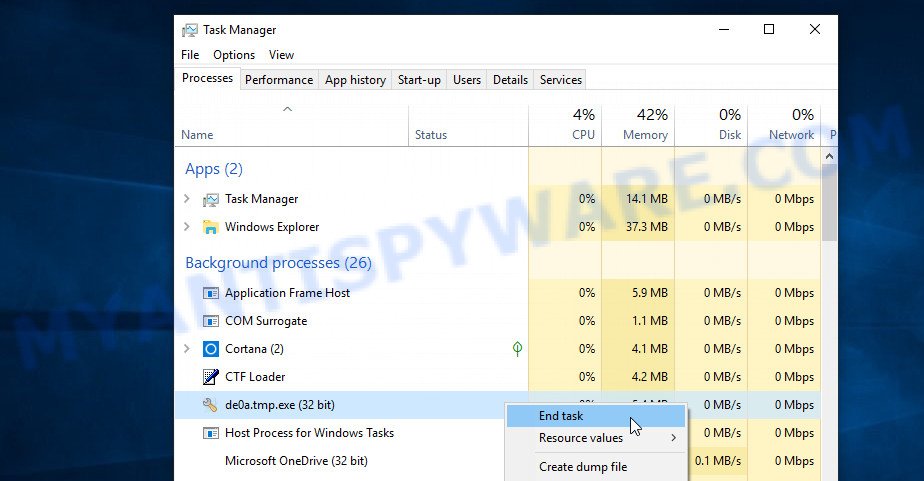
A process is particularly suspicious: it is taking up a lot of memory (despite the fact that you closed all of your programs, its name is not familiar to you (if you are in doubt, you can always check the program by doing a search for its name in Google, Yahoo or Bing).
Disable the Erif ransomware Start-Up
Select the “Start-Up” tab, look for something similar to the one shown in the example below, right click to it and select Disable.
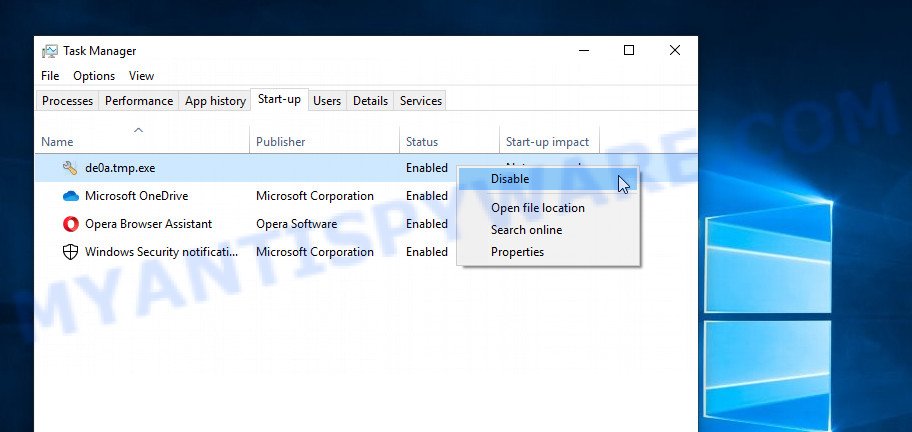
Close Task Manager.
Delete the Erif ransomware Task
Type “Task Scheduler” in the search bar. Click Task Scheduler app in the search results. Click “Task Scheduler Library” in the left panel. On the right panel, right-click to “Time Trigger Task” and select Delete.
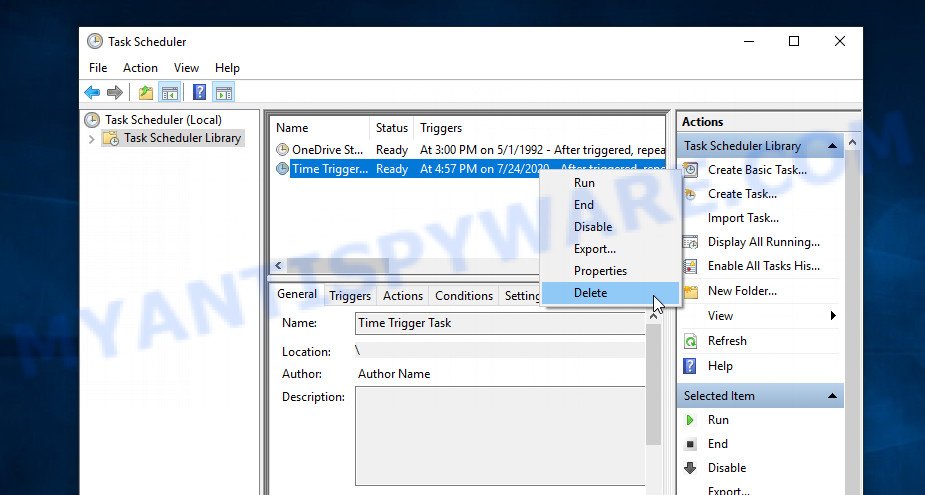
Close Task Scheduler.
Delete the Erif ransomware File
Run Task Manager and select the “Start-Up” tab. Right click to the Erif ransomware Start-Up entry and select Open File Location as shown below.
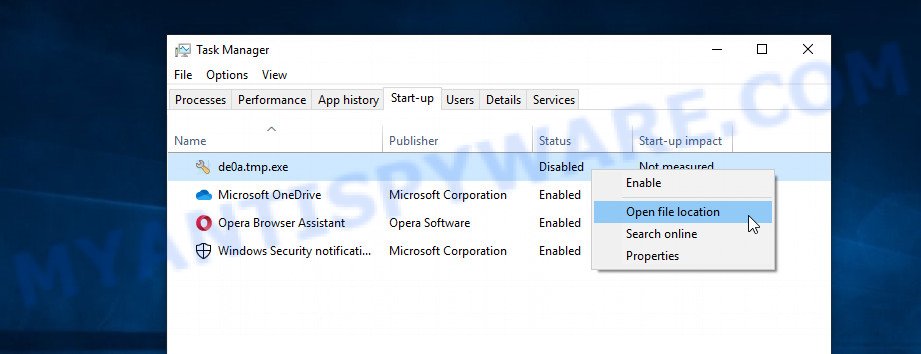
A directory containing one file will open in front of you, this file is the Erif ransomware. It needs to be removed. If you try to delete it immediately, then you will not succeed, since this file is protected from deletion.
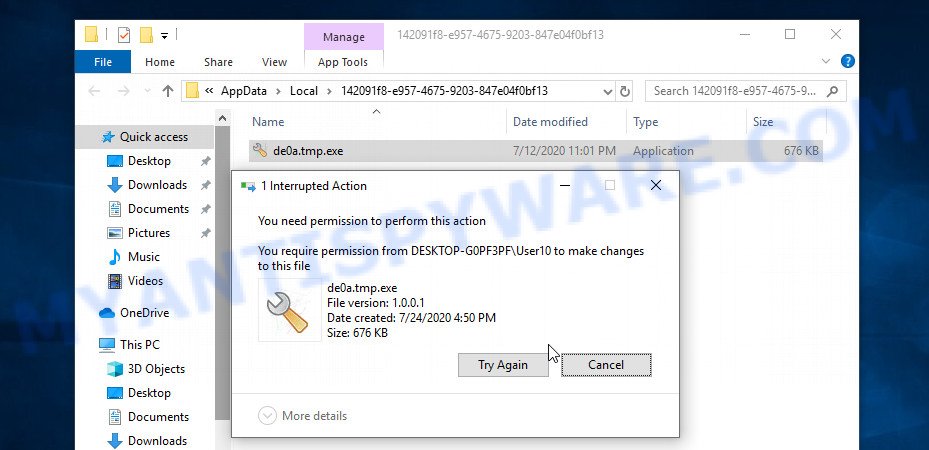
To delete this file, you need to do the following. Right-click on the file, select Properties. In the window that opens, select Security tab. Next, click the Advanced button below. A window will open as shown in the following example.
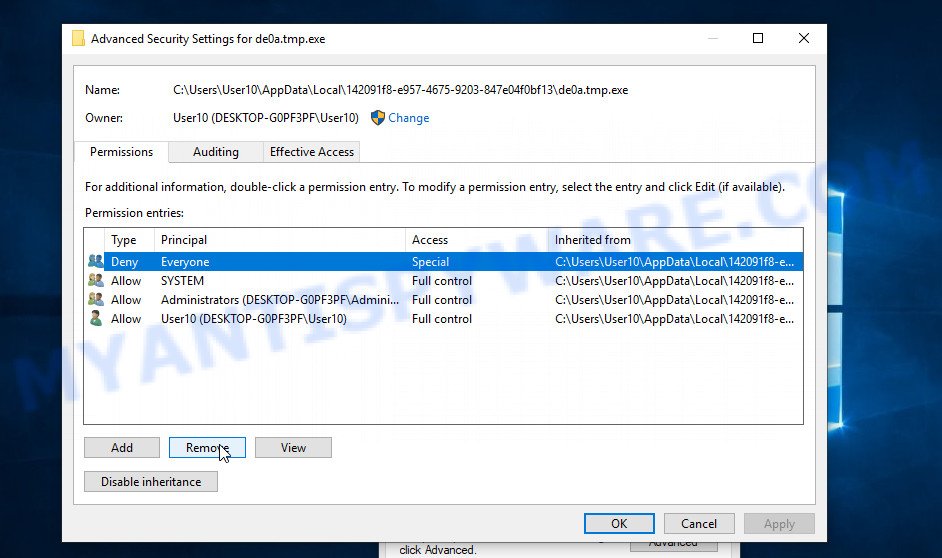
Click Disable inheritance. In the Block inheritance dialog box that opens, select the first item (Convert inherited permissions…) as shown below.
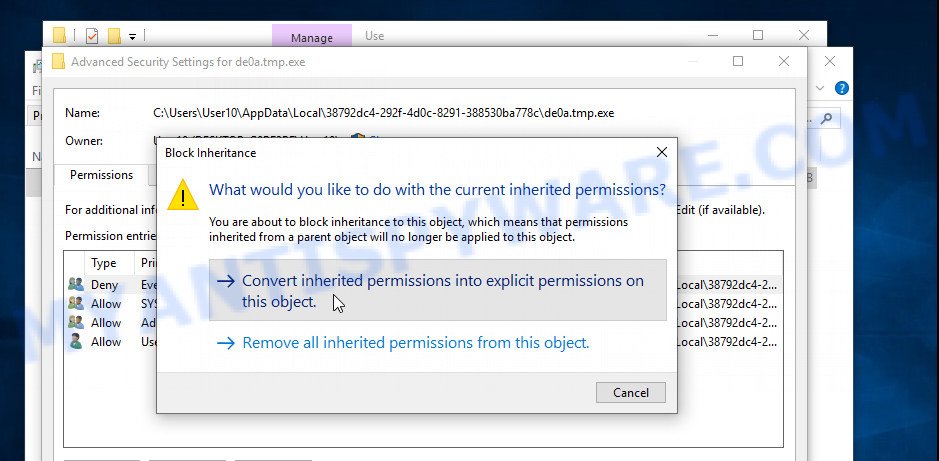
In the Permission entries list, select “Deny Everyone”, click Remove button and then OK. Close the file properties window. You should now be able to remove the Erif ransomware File. Right-click on the file and select Delete.
Scan computer for malware
Zemana highly recommended, because it can detect security threats such as the Erif ransomware, other malicious software and trojans that most ‘classic’ antivirus applications fail to pick up on. Moreover, if you have any Erif removal problems which cannot be fixed by this tool automatically, then Zemana provides 24X7 online assistance from the highly experienced support staff.

- Visit the page linked below to download the latest version of Zemana Anti Malware (ZAM) for MS Windows. Save it on your Desktop.
Zemana AntiMalware
164813 downloads
Author: Zemana Ltd
Category: Security tools
Update: July 16, 2019
- When downloading is complete, close all software and windows on your PC system. Open a file location. Double-click on the icon that’s named Zemana.AntiMalware.Setup.
- Further, press Next button and follow the prompts.
- Once installation is finished, press the “Scan” button . Zemana Anti-Malware (ZAM) tool will begin scanning the whole system to find out the Erif crypto malware related folders,files and registry keys. A scan may take anywhere from 10 to 30 minutes, depending on the number of files on your PC and the speed of your machine. While the Zemana tool is scanning, you may see how many objects it has identified as being infected by malware.
- After the scan is done, it will display the Scan Results. Review the results once the utility has complete the system scan. If you think an entry should not be quarantined, then uncheck it. Otherwise, simply click “Next”. After finished, you may be prompted to reboot your PC.
In order to be 100% sure that the computer no longer has the Kuus ransomware virus, we recommend using Kaspersky virus removal tool (KVRT). It is a free malware removal tool that can be downloaded and used to delete ransomware, adware, spyware, trojans, worms, PUPs, and other security threats from the system. You can use this utility to find threats even if you have an antivirus or any other security program.
Download Kaspersky virus removal tool (KVRT) from the following link. Save it to your Desktop so that you can access the file easily.
129233 downloads
Author: Kaspersky® lab
Category: Security tools
Update: March 5, 2018
Once the downloading process is complete, double-click on the Kaspersky virus removal tool icon. Once initialization process is complete, you will see the Kaspersky virus removal tool screen as displayed in the figure below.

Click Change Parameters and set a check near all your drives. Press OK to close the Parameters window. Next press Start scan button to look for Erif crypto malware and other malicious software. A scan can take anywhere from 10 to 30 minutes, depending on the count of files on your personal computer and the speed of your machine. When a threat is detected, the count of the security threats will change accordingly.

When Kaspersky virus removal tool is complete scanning your personal computer, KVRT will produce a list of unwanted programs and crypto malware like below.

You may remove items (move to Quarantine) by simply click on Continue to start a cleaning task.
How to decrypt .erif files
As we already reported above, files with .erif extension are files that have been encrypted by the Erif ransomware virus. Their contents will remain locked until decrypted using the decryptor and the key. Fortunately, there is a free Erif File Decrypt Tool that can decrypt .erif files. Below we provide instructions on where to download and how to use this decryptor.

Erif File Decrypt Tool (STOP Djvu decryptor)
To decrypt .erif files, use free Erif File Decrypt Tool
- Download Erif File Decrypt Tool from the following link.
STOP Djvu decryptor - Scroll down to ‘New Djvu ransomware’ section.
- Click the download link and save the decrypt_STOPDjvu.exe file to your desktop.
- Run decrypt_STOPDjvu.exe, read the license terms and instructions.
- On the ‘Decryptor’ tab, using the ‘Add a folder’ button, add the directory or disk where the encrypted files are located.
- Click the ‘Decrypt’ button.
Erif File Decrypt Tool is a free software that can decrypt files only in some cases, when the files were encrypted with an ‘offline key’. Files encrypted with an online key cannot yet be decrypted. The online key is unique to each infected computer, and at the moment there is no way to find this key. Of course, the Erif ransomware authors own this key, but we do not think that paying a ransom is the right way to decrypt .erif files. In the case when the files are encrypted with an online key, there is a chance to restore the encrypted files using alternative methods, which are described below.
How to find out which key was used to encrypt files
Since Erif File Decrypt Tool only decrypts files encrypted with the offline key, each virus victim needs to find out which key was used to encrypt the files. Determining the type of key used is not difficult. Below we give two ways. Use any of them.
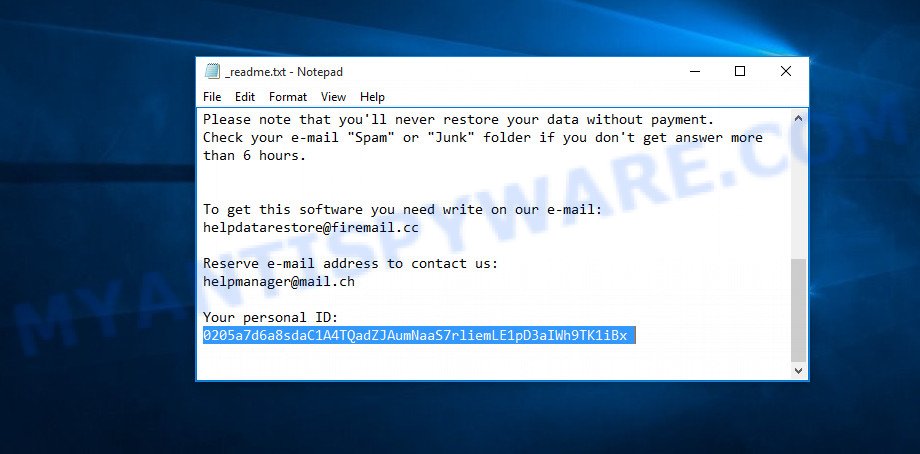
Personal ID is highlighted here
Find out the type of key using ‘_readme.txt’ file
- Open the ransom demand message (‘_readme.txt’ file).
- Scroll down to the end of the file.
- There you will see a line with the text ‘Your personal ID’.
- Below is a line of characters that starts with ‘0242’ – this is your personal id.
Find out the type of key using ‘PersonalID.txt’ file
- Open disk C.
- Open directory ‘SystemID’.
- Open file named ‘PersonalID.txt’. This file lists “Personal ID”s that match the keys that the virus used to encrypt files.
The ‘Personal ID’ is not a key, it is an identifier related to a key that was used to encrypt files. If the ID ends with ‘t1’, then the files are encrypted with an offline key. If the ID does not end with ‘t1’, the Erif virus used an online key. If you could not figure out how to determine which key was used to encrypt files, then we can help. Just write a request here or in the comments below.
Erif File Decrypt Tool : “No key for New Variant online ID”
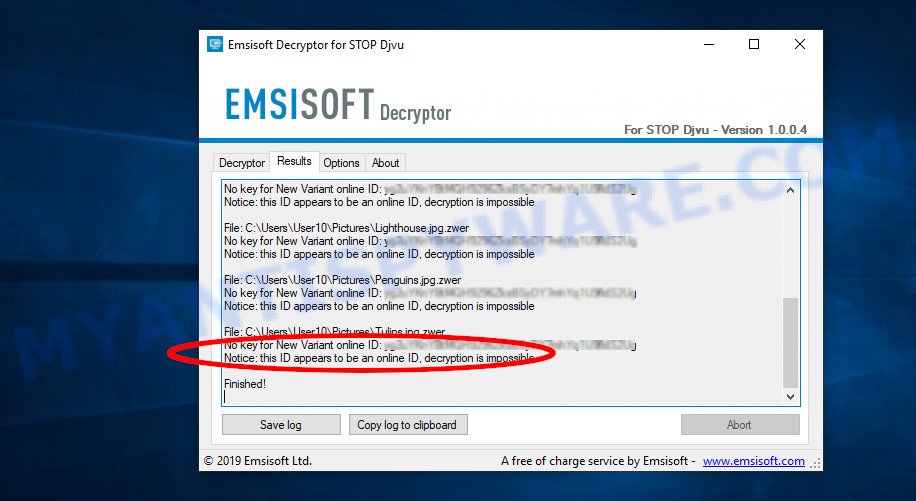
If, when you try to decrypt .erif files, Erif File Decrypt Tool reports:
No key for New Variant online ID: *
Notice: this ID appears to be an online ID, decryption is impossible
It means that your files are encrypted with an ‘online key’ and their decryption is impossible, since only the Erif authors have the key necessary for decryption. In this case, you need to use alternative methods listed below to restore the contents of encrypted files.
Erif File Decrypt Tool : “No key for New Variant offline ID”
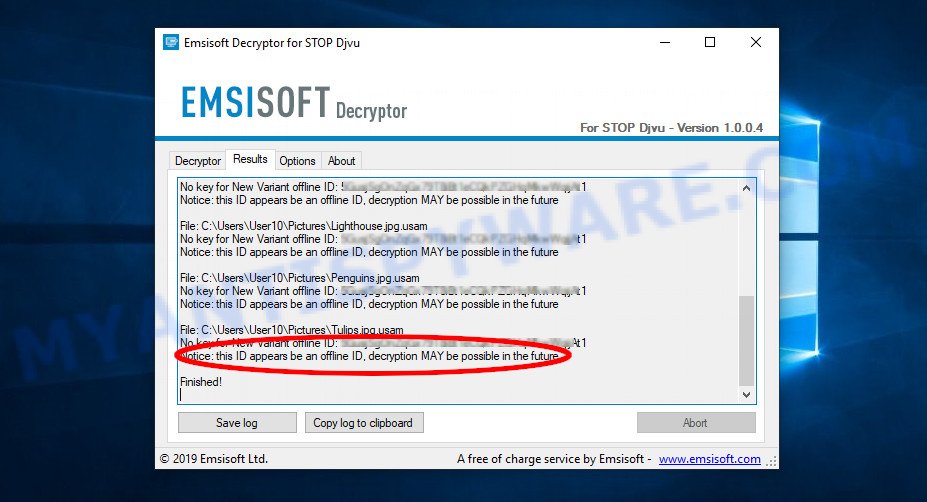
If, during decryption of .erif files, Erif File Decrypt Tool reports:
No key for New Variant offline ID: *t1
Notice: this ID appears be an offline ID, decryption MAY be possible in the future.
It means the following: your files are encrypted with an ‘offline key’, but the key itself has not yet been obtained by security researchers, in this case, you need to be patient and wait a while, in addition, you can also use alternative ways for recovering encrypted data.
If for some reason you were unable to decrypt the encrypted files, then We recommend to follow the news on our Facebook or YouTube channels. So you ‘ll know right away that it ‘s possible to decrypt .erif files.
This video step-by-step guide will demonstrate How to remove Erif ransomware and Decrypt/Recover .erif files.
How to restore .erif files
As we mentioned above, in addition to using the Erif File Decrypt Tool, there are several more methods for recovering encrypted files. These methods do not require the use of a decryptor and a key, and therefore are suitable for all cases when the virus used an online key, and for the case when the virus used an offline key. It is very important to check your computer for malware before you try to recover encrypted files. You must be 100% sure that the Erif ransomware virus is completely removed. To scan your computer for ransomware, use free malware removal tools.
Restore .erif files with ShadowExplorer
The Microsoft Windows has a feature called ‘Shadow Volume Copies’ that can help you to recover .erif files encrypted by the ransomware. A small tool called ShadowExplorer will allow you to easily access the Shadow copies and restore the encrypted files to their original state. Unfortunately, the ransomware can delete these Shadow copies before it starts encrypting files. Therefore, if ShadowExplorer did not help you, then try another method, which is given below.
Visit the following page to download ShadowExplorer. Save it on your Windows desktop.
439456 downloads
Author: ShadowExplorer.com
Category: Security tools
Update: September 15, 2019
Once downloading is finished, open a directory in which you saved it. Right click to ShadowExplorer-0.9-portable and select Extract all. Follow the prompts. Next please open the ShadowExplorerPortable folder as displayed below.

Start the ShadowExplorer utility and then choose the disk (1) and the date (2) that you want to restore the shadow copy of file(s) encrypted by the Erif ransomware virus as on the image below.

Now navigate to the file or folder that you want to restore. When ready right-click on it and click ‘Export’ button like below.

This video step-by-step guide will demonstrate How to recover encrypted files using Shadow Explorer.
Recover .erif files with PhotoRec
The last chance to restore .erif files to their original state is using data recovery tools. We recommend a program called PhotoRec. It has all the necessary functions to restore the contents of encrypted files. It helped many victims recover data when it seemed like there was no more hope.
Download PhotoRec on your MS Windows Desktop from the following link.
After the downloading process is complete, open a directory in which you saved it. Right click to testdisk-7.0.win and choose Extract all. Follow the prompts. Next please open the testdisk-7.0 folder as displayed in the figure below.

Double click on qphotorec_win to run PhotoRec for Microsoft Windows. It will display a screen as displayed below.

Select a drive to recover as displayed in the figure below.

You will see a list of available partitions. Choose a partition that holds encrypted personal files as on the image below.

Press File Formats button and specify file types to restore. You can to enable or disable the restore of certain file types. When this is done, click OK button.

Next, press Browse button to choose where recovered files should be written, then click Search. We strongly recommend that you use an external device to save the restored files!

Count of recovered files is updated in real time. All restored files are written in a folder that you have chosen on the previous step. You can to access the files even if the recovery process is not finished.
When the restore is finished, press on Quit button. Next, open the directory where restored photos, documents and music are stored. You will see a contents as shown on the screen below.

All restored documents, photos and music are written in recup_dir.1, recup_dir.2 … sub-directories. If you’re looking for a specific file, then you can to sort your restored files by extension and/or date/time.
This video step-by-step guide will demonstrate How to recover encrypted files using PhotoRec.
How to protect your computer from Erif ransomware
Most antivirus programs already have built-in protection system against the ransomware virus. Therefore, if your system does not have an antivirus application, make sure you install it. As an extra protection, use the HitmanPro.Alert. HitmanPro.Alert is a small security tool. It can check the system integrity and alerts you when critical system functions are affected by malware. HitmanPro.Alert can detect, remove, and reverse ransomware effects.
Download HitmanPro.Alert on your Windows Desktop from the following link.
Once the download is done, open the file location. You will see an icon like below.

Double click the HitmanPro.Alert desktop icon. After the tool is launched, you’ll be displayed a window where you can choose a level of protection, as on the image below.

Now click the Install button to activate the protection.
Finish words
This guide was created to help all victims of the Erif ransomware virus. We tried to give answers to the following questions: how to remove ransomware; how to decrypt .erif files; how to recover files, if the Erif File Decrypt Tool does not help; what is an online key and what is an offline key. We hope that the information presented in this manual has helped you.
If you have questions, then write to us, leaving a comment below. If you need more help with Erif related issues, go to here.





















Sir, due to panic and urgency of use my laptop, I reinstalled windows and also deleted readme files…..but before that I have used the decrypt_STOPDjvu software and it says online key…..I need your help to restore my files.
Try PhotoRec as soon as possible, there is a hope that you will be able to recover some of the encrypted files.